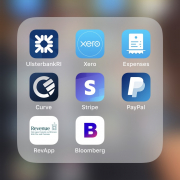3 apps and 3 phone actions that will save you hours every month
Every summer I give one of these articles over to the subject of apps that I use regularly. This year I’m taking a slightly different route… I’m only going to highlight 3 apps that I use pretty much every day, however they each save me hours of work over the course of every month. I’m then going to set out 3 actions you can take with your mobile phone that will also give you back many hours every month.
First of all, let’s take a look at my 3 most useful apps.
Xero
I’ve been a very satisfied user of Xero, an online accounting system for a number of years now. It has had a transformational effect on the financial management side of my business. It delivers real-time profit & loss statements, balance sheet and a host of other useful reports that are available at the press of a button. All my invoicing and bank reconciliations are done through Xero, as is management of expenses, and my accountant and I can both view the up to the minute real time information about my business.
Specifically the phone app provides a great overview of business bank accounts and of invoices and purchases. Bank accounts are reconciled with Xero as transactions happen, and I’ve a full view of my outstanding invoices and other important information. I now have all the information I need, and am saving hours (if not more) every month with Xero. If you’re still sending files / receipts etc. to your accountant every month and manually issuing invoices, you need to have a chat with your accountant. There’s a better way…
Feedly
Feedly is an app that I use all of the time in seeking out useful content from the web to share, and indeed for content ideas to write about. It enables me to track blogs / news feeds that provide content I don’t want to miss. Rather than receiving an email every time there’s a new blog post or news article, instead the new content is sent to Feedly which gathers all of these articles in one place. It is like a magazine rack for online articles, waiting for me to go through them.
I can then flick down through hundreds of articles in minutes, reading only the headlines, dipping into an introduction or indeed the full article if I think it is actually worth reading. And I can mark them all as “Already read” very easily as I go along, ensuring those particular articles don’t appear again. I’ve categorised the different feeds into groups, which further speeds up the process too. The benefit of Feedly is the time it saves me in getting through huge numbers of articles.
And then there’s Pocket, which is my scrapbook of articles that I’ve “cut out” and saved for later. As I see articles of interest on the web or that come through to Feedly, some catch my attention to be read later when I’ve a bit more time on my hands. With 2 clicks, I put them in my Pocket and can also tag the articles for different purposes – it might be to share out later, to rewrite with my perspective, maybe to help me develop a new angle for my proposition etc.
I can then go back into Pocket when I want to carry out an activity and simply click on the article that I’ve saved for that very purpose. It’s all very easy and it means you don’t lose great articles that you’ve read.
And now for 3 actions you can take with your mobile phone that will also save you hours every month.
Delete the Facebook app
I’m not saying you shouldn’t be on Facebook, I’m simply saying to get rid of the app from your phone. It has to be the greatest distraction out there. Facebook is so clever at putting content that you want to read in front of you, it is next to impossible to just quickly dip in and out of. I deleted the app from my phone, and this saves me lots of time now during the working day. Because I can only access it through a browser, I rarely bother. Facebook is something I now really only access in the evenings when I’m chilling out…
Turn off notifications
Push notifications on your phone and computer provide major distractions. They are rarely urgent, but they are great attention grabbers and are very hard to ignore. But do I need to see the 25 “Yes” responses for my son’s football training tonight? Of course not.
Mute noisy WhatsApp groups for the day and even turn off notifications for some apps that you never need to see. You’ll work more effectively and free up more time for yourself.
Turn on Downtime
Many of us think of the Downtime setting on iPhones in relation to getting kids off their phones. But many of us need help in staying away from our own phones! Downtime is a setting within the Screen Time settings on iPhones that allows you to turn off some or all apps for specific time periods. This can be really useful if you need time to concentrate on a task, as you simply can’t access the apps that might distract you. It’s like a “full metal jacket” alternative to turning off your notifications. I now have a few set periods during the week where my phone turns into my old Nokia phone (calls and text only). These are the hours when I need quiet time to get work done.
Take a few minutes to explore some of these – you might find a way of getting a few valuable hours back each month.







